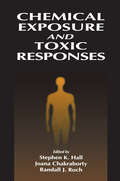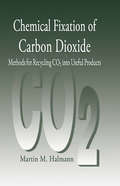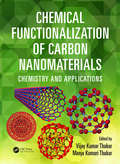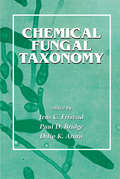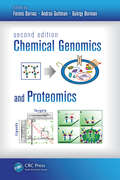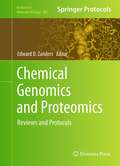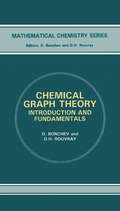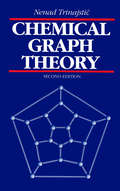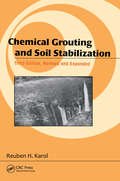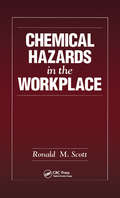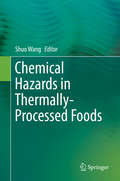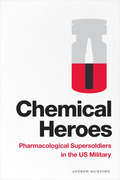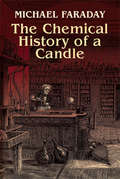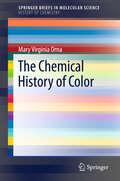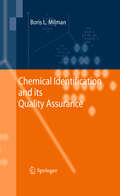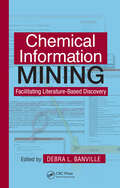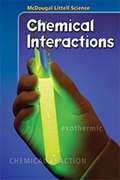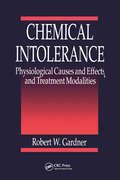- Table View
- List View
Chemical Exposure and Toxic Responses
by Stephen K. HallProviding material for practitioners and students alike, Chemical Exposure and Toxic Responses is a clear and straightforward presentation of industrial toxicology.Exposure to toxic chemicals is of major concern to health professionals. In recent years, the scope and importance of hazardous materials toxicology has expanded and now impacts financial institutions, government, private corporations, and many other organizations as well. Chemical Exposure and Toxic Responses presents the myriad health implications of hazardous chemicals in a single source. This book is organized so that readers can proceed from a general perspective on the problem of chemical exposure and toxic responses to an understanding of toxicology and a method of inquiry.Written for anyone who needs practical toxicological information, the book compactly and efficiently presents the scientific basis of toxicology as it applies to the workplace. It covers the diverse chemical hazards encountered in the work environment and provides a practical understanding of these hazards for those charged with protecting the health and well being of people at work.Chemical Exposure and Toxic Responses consists of three parts: Part I establishes the general principles of industrial toxicology; Part II addresses specific effects of toxic agents on specific physiological organs and systems; and Part III is devoted to the evaluation of hazards in the workplace.
Chemical Fixation of Carbon DioxideMethods for Recycling CO2 into Useful Products
by Martin M. HalmannChemical Fixation of Carbon Dioxide presents new concepts and results from research into the problems caused by increasing levels of carbon dioxide. The book discusses the limitations of natural plant photosynthesis as a sink for carbon dioxide and emphasizes chemical fixation as an important alternative. A number of significant topics are covered, including new coupling reactions for producing compounds such as carbamates, urethanes, and heterocyclic structures; new catalyst systems, particularly for methanation and methanol synthesis; the use of homogeneous solution photosensitizers and heterogeneous semiconductor photocatalysts to photoreduce carbon dioxide with visible light and sunlight; and electrochemical reduction. This book will be a useful reference for organic chemists working on environmental problems, chemical engineers, environmental chemists, professionals at research facilities, and students.
Chemical Functionalization of Carbon Nanomaterials: Chemistry and Applications
by Vijay Kumar Thakur Manju Kumari ThakurCarbon-based nanomaterials are rapidly emerging as one of the most fascinating materials in the twenty-first century. Chemical Functionalization of Carbon Nanomaterials: Chemistry and Applications provides a thorough examination of carbon nanomaterials, including their variants and how they can be chemically functionalized. It also gives a comprehe
Chemical Fungal Taxonomy
by Jens C. FrisvadOffers comprehensive coverage of the latest developments in both biochemical and physiological approaches to fungal systematics. Incorporates recent advances in molecular biology into systematics methods that can revolutionize taxonomic schemes.
Chemical Genomics
by Haian FuAdvances in chemistry, biology, and genomics coupled with laboratory automation and computational technologies have led to the rapid emergence of the multidisciplinary field of chemical genomics. This edited text with contributions from experts in the field discusses evolving concepts, essential techniques, and a wide range of applications to help further the study of chemical genomics. The beginning chapters provide an overview of the basic principles of chemical biology and chemical genomics. This is followed by a technical section that describes the sources of small molecule chemicals, the basics of high-throughput screening technologies, various bioassays for biochemical-, cellular-, and organism-based screens, and computational approaches. The final chapters connect the chemical genomics field with personalized medicine and the druggable genome for future discovery of new therapeutics. In selected chapters, a resource section is included for further information. This book provides an introduction to the principles of chemical genomics, serves as a resource for the associated technologies, and gives readers general concepts, useful vocabulary, practical techniques, and broad, forward-thinking perspectives. This book will be valuable to researchers, professionals, and students in many fields besides chemical genomics, including biology, biomedicine, chemistry, and drug discovery.
Chemical Genomics: Reviews and Protocols (Methods in Molecular Biology #310)
by Edward D. ZandersAn up-to-date introduction for the uninitiated into the various "flavors" of chemical genomics with a series of readily reproducible techniques for applications in organic chemistry, protein chemistry, and computer science, emphasizing the high-throughput approaches that are the essence of chemical genomics. The techniques range from the classic design of small molecules as affinity ligands for specific protein families, to in silico docking for computational approaches to protein-small molecule interactions, to producing highly diverse collections of proteins, carbohydrates, and small molecules for use in arrays containing large numbers of these molecules. There are also methods for the production of proteins and carbohydrates using different expression systems, for analyzing proteins using mass spectrometry, and for arraying proteins and carbohydrates on solid supports. The protocols follow the successful Methods in Molecular BiologyTM series format, each offering step-by-step laboratory instructions, an introduction outlining the principles behind the technique, lists of the necessary equipment and reagents, and tips on troubleshooting and avoiding known pitfalls.
Chemical Genomics and Proteomics
by András Guttman Ferenc Darvas György DormánSince the publication of the pioneering first edition of Chemical Genomics and Proteomics more than seven years ago, the area of chemical genomics has rapidly expanded and diversified to numerous novel methods and subdisciplines, such as chemical glycomics and lipidomics. This second edition has been updated to uniquely reflect this interdisciplinary feature as well as the remarkable developments that have occurred. The new edition also covers innovative applications from cell biology to drug discovery to, more recently, clinical diagnostics and medical practice.
Chemical Genomics and Proteomics: Reviews and Protocols (Methods in Molecular Biology #800)
by Edward D. ZandersChemical genomics technology has been steadily improving, delivering new biological probes and drugs, and the explicit use of the term 'chemical proteomics' has increased with it, as proteins have always been at the heart of this technology. In Chemical Genomics and Proteomics: Reviews and Protocols, experts in the field present updated reviews of the chemistry of small molecules and their interaction with protein targets as well as detailed protocols that cover different types of ligands, carbohydrates, and lipids. For example, the generation of their protein targets and methods for measuring their interactions is covered. Written in the highly successful Methods in Molecular BiologyTM series format, methodology chapters include introductions to their respective topics, lists of the necessary materials and reagents, step-by-step, readily reproducible laboratory protocols, and tips on troubleshooting and avoiding known pitfalls. Thorough and up to date, Chemical Genomics and Proteomics: Reviews and Protocols aims to provide inspiration to those who wish to use chemical genomics and proteomics in their work and develop this young field into full maturity through the incorporation of the new biological and chemical technologies beginning to emerge here.
Chemical Graph Theory: Introduction and Fundamentals (Mathematical Chemistry Ser.)
by D BonchevThis volume presents the fundamentals of graph theory and then goes on to discuss specific chemical applications. Chapter 1 provides a historical setting for the current upsurge of interest in chemical graph theory. Chapter 2 gives a full background of the basic ideas and mathematical formalism of graph theory and includes such chemically relevant notions as connectedness, graph matrix representations, metric properties, symmetry and operations on graphs. This is followed by a discussion on chemical nomenclature and the trends in its rationalization by using graph theory, which has important implications for the storage and retrieval of chemical information. This volume also contains a detailed discussion of the relevance of graph-theoretical polynomials; it describes methodologies for the enumeration of isomers, incorporating the classical Polya method, as well as more recent approaches.
Chemical Graph Theory
by Nenad TrinajsticNew Edition! Completely Revised and UpdatedChemical Graph Theory, 2nd Edition is a completely revised and updated edition of a highly regarded book that has been widely used since its publication in 1983. This unique book offers a basic introduction to the handling of molecular graphs - mathematical diagrams representing molecular structures. Using mathematics well within the vocabulary of most chemists, this volume elucidates the structural aspects of chemical graph theory: (1) the relationship between chemical and graph-theoretical terminology, elements of graph theory, and graph-theoretical matrices; (2) the topological aspects of the Hückel theory, resonance theory, and theories of aromaticity; and (3) the applications of chemical graph theory to structure-property and structure-activity relationships and to isomer enumeration. An extensive bibliography covering the most relevant advances in theory and applications is one of the book's most valuable features. This volume is intended to introduce the entire chemistry community to the applications of graph theory and will be of particular interest to theoretical organic and inorganic chemists, physical scientists, computational chemists, and those already involved in mathematical chemistry.
Chemical Grouting And Soil Stabilization, Revised And Expanded
by Reuben H. KarolFollowing shifting trends from remedial to preventive uses of grouting practices, this third edition covers all aspects of chemical grouting methods and applications. This reference highlights new ground improvement techniques as well as recent innovations in soil modification and stabilization procedures. It considers commercial alternatives to ground improvement, their relative advantages and disadvantages, and the engineering applications to which these methods are suited. Revised and expanded, this new edition assesses the role of new grouting techniques in the containment of hazardous waste and introduces numerous problems to illustrate concepts and facilitate instruction.
Chemical Hazards in the Workplace
by Ronald M. ScottThis book introduces you to Industrial Toxicology - and is especially valuable for the engineer, scientists, or manager with responsibility - but no previous education or experience in the subject. Very "User Friendly." Text at the upper undergraduate and graduate level.
Chemical Hazards in Thermally-Processed Foods
by Shuo WangThis book summarizes the types, contents, analytical methods, formation mechanisms and control strategies for hazardous substances produced during the thermal processing of foods. In each chapter, hazardous substances such as dicarbonyl compounds, acrylamide, furan, heterocyclic amines, trans-fatty acids, and advanced glycation end products (AGEs) are covered and discussed in terms of analytical methods, formation mechanisms and mitigation strategies.The content chiefly focuses on how these hazardous substances are formed during thermal processing and what can be done to mitigate or eliminate them in food products (e.g. those prepared at higher temperatures by baking, frying or roasting).The major objective of this book is to provide a timely and informative guide for researchers and graduate students in the fields of food chemistry, food ingredients, food analysis, food safety, food processing, chemical toxicology, disease prevention and health promotion.
Chemical Heroes: Pharmacological Supersoldiers In The Us Military
by Andrew BickfordIn Chemical Heroes Andrew Bickford analyzes the US military's attempts to design performance enhancement technologies and create pharmacological "supersoldiers" capable of withstanding extreme trauma. <P><P>Bickford traces the deep history of efforts to biologically fortify and extend the health and lethal power of soldiers from the Cold War era into the twenty-first century, from early adoptions of mandatory immunizations to bio-protective gear, to the development and spread of new performance enhancing drugs during the global War on Terrorism. In his examination of government efforts to alter soldiers' bodies through new technologies, Bickford invites us to contemplate what constitutes heroism when armor becomes built in, wired in, and even edited into the molecular being of an American soldier. Lurking in the background and dark recesses of all US military enhancement research, Bickford demonstrates, is the desire to preserve US military and imperial power.
The Chemical History of a Candle
by Michael FaradayOne of the greatest experimental scientists of all time, Michael Faraday (1791–1867) developed the first electric motor, electric generator, and dynamo — essentially creating the science of electrochemistry. This book, the result of six lectures he delivered to young students at London’s Royal Institution, concerns another form of energy — candlelight.Faraday titled the lectures "The Chemical History of a Candle," choosing the subject because, as he explained, "There is not a law under which any part of this universe is governed which does not come into play and is not touched upon [during the time a candle burns]."That statement is the foundation for a book that describes, with great clarity, the components, function and weight of the atmosphere; the function of a candle wick; capillary attraction; the carbon content in oxygen and living bodies; the production of carbon dioxide from coal gas and sugar; the properties of carbonic acid; respiration and its analogy to the burning of a candle; and much more. There is also a chapter comprising Faraday's "Lecture on Platinum."A useful classroom teaching tool, this classic text will also appeal to a wide audience interested in scientific inquiry.
The Chemical History of Color
by Mary Virginia OrnaIn this brief, Mary Virginia Orna details the history of color from the chemical point of view. Beginning with the first recorded uses of color and ending in the development of our modern chemical industry, this rich, yet concise exposition shows us how color pervades every aspect of our lives. Our consciousness, our perceptions, our useful appliances and tools, our playthings, our entertainment, our health, and our diagnostic apparatus - all involve color and are based in no small part on chemistry.
Chemical Identification and its Quality Assurance
by Boris L. MilmanThis is the first book to show how to apply the principles of quality assurance to the identification of analytes (qualitative chemical analysis). After presenting the principles of identification and metrological basics, the author focuses on the reliability and the errors of chemical identification. This is then applied to practical examples such as EPA methods, EU, FDA, or WADA regulations. Two whole chapters are devoted to the analysis of unknowns and identification of samples such as foodstuffs or oil pollutions. Essential reading for researchers and professionals dealing with the identification of chemical compounds and the reliability of chemical analysis.
Chemical Information Mining: Facilitating Literature-Based Discovery
by Debra L. BanvilleThe First Book to Describe the Technical and Practical Elements of Chemical Text MiningExplores the development of chemical structure extraction capabilities and how to incorporate these technologies in daily research workFor scientific researchers, finding too much information on a subject, not finding enough information, or not being able&nb
Chemical Interactions: FOSS Science Resources
by Lawrence Hall of Science University of California at BerkeleyNIMAC-sourced textbook
Chemical Interactions
by Lawrence Hall of Science University of California at BerkeleyNIMAC-sourced textbook
Chemical Interactions Resources: Images, Data, and Readings
by Lawrence Hall of ScienceThis book explores chemicals, for instance, their formation, reactions and properties.
Chemical Intolerance: Physiological Causes and Effects and Treatment Modalities
by Robert W. GardnerChemical Intolerance identifies phenolic (aromatic) chemical compounds present in natural foodstuffs, pollens, certain food additives, tobacco smoke, perfumes, air pollution, etc., as nonimmunologic, but pharmacologic activators of allergic reactions in chemically intolerant individuals. Biochemical pathway sequences, with supporting scientific literature, are outlined to elucidate the mechanisms associated with formation of inflammatory mediators (prostaglandins, thromboxanes, and leukotrienes) upon activation by phenolic compounds and other chemical stimulants. The role of these inflammatory agents in respiratory, gastrointestinal, neurological, cardiovascular, and other disorders is discussed. Treatment modalities using precise dosages of selected phenolic compounds are outlined to provide clinicians with an effective means of therapy. The author also shares his own experience and personal findings based on 20 years of research, including his recommendations for therapy.
